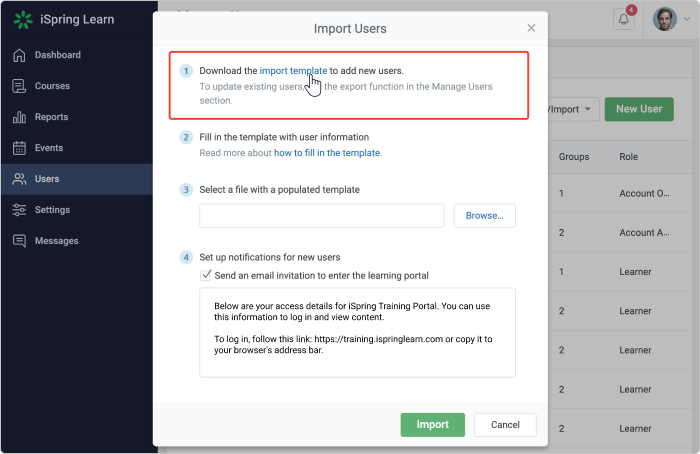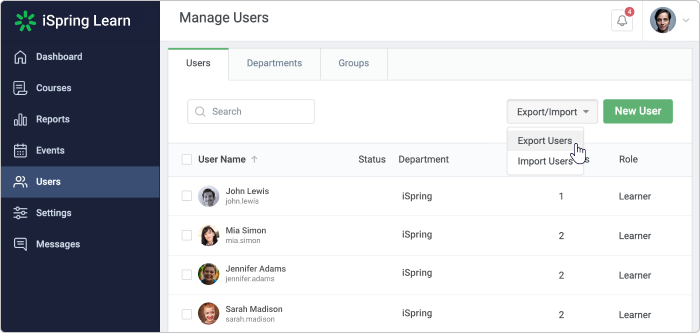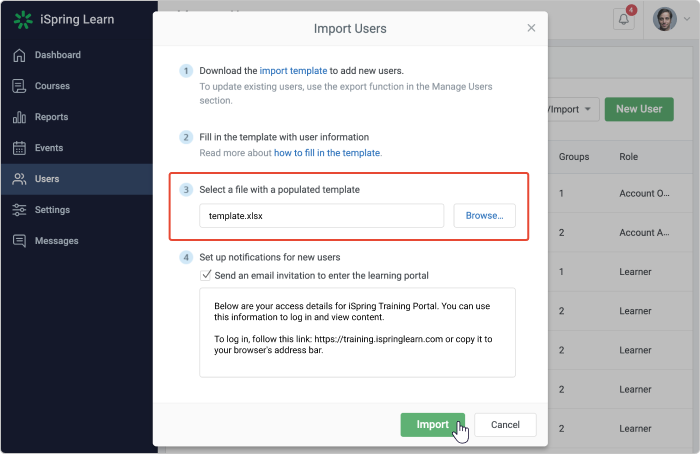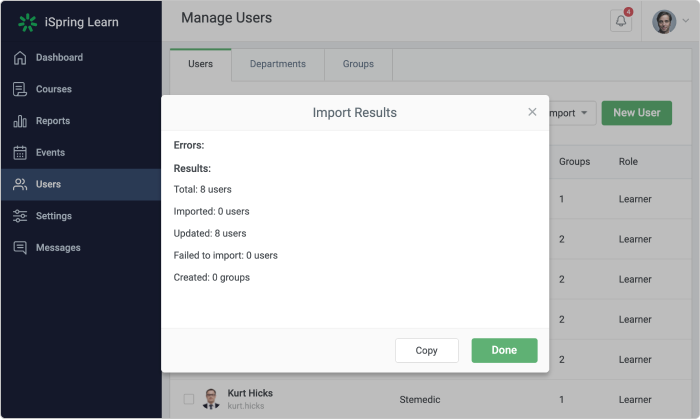iSpring Learn LMS: how to import users from file
There are two ways to add new users in iSpring Learn LMS: via email or by importing a XLSX file. Import is a good option if you need to edit or add information about several users at once.
Importing users via Excel files
You don’t need to mess up with the encodings and strings of CSV files, you can just use an XLSX-template and work with it in a familiar table format.
With the import option, you can add and edit information about iSpring Learn users, as well as create user groups.
Also you can add, edit or delete language versions of User Portal in iSpring LMS using a Localisation file. It can be accessed in the Additional Options panel under the Settings tab.
How to change/add user details using file import
Step 1. Download a XLSX template
If you need to add new users, you can download a template for import. To do this, go to People → Users → Add New User and select the Import from file tab. In this tab, you can download a .xlsx template file.

If you want to edit the information about your learners, first you need to export your user list.
To do this, go to the Users tab from the left side menu. In the upper right part of the window, click the Export/Import button and choose Export Users in the drop-down list.

Note: With the exported file, you can also add new users or new user groups.
Step 2. Edit user details
To change the information about your existing users, open the XLSX file in Excel and edit the data without changing the structure of the file. In this file, you can also add new users. To do this, just fill in the new rows with new users’ details.
The import template and the export file have the same structure. Please note that when you add new users, some columns don’t need to be filled in (e.g., the Reporter column).
Let’s take a closer look at the user details in the template:
- You can change a user’s email, password, name and surname, job title, company name, and address.
- In the Users tab, you can customize the user profile fields. If you’ve set some profile fields to be mandatory, for example, City or Job title, then these fields should be filled when editing the import template.
- If you need to add a user to one or more groups, just add the titles of these groups in separate columns. Even if there’s no group with this title in your account, it will be automatically created when importing users.
- The Department ID column. Each user should belong to a department, and each department should have a certain code (ID) in the LMS. For example, if you specified the "01" ID for your Sales department in the department settings, users from the Sales team should have "01" in the Department ID column. This column can't be left empty.
- The Active column. Type No to deactivate the user, or leave the cell empty if the user is still active.
- The Last Login column is not necessary when importing users. When exporting, this column contains the date when the user last logged into the system.
- The Added column also shouldn’t be filled in when importing users. It is filled when exporting learners, and contains the date when the user was added in the account.
When you’ve added all the necessary data, save the changes.
Step 3. Uploading data to the LMS
Now you can upload the user list back into the LMS:
-
Go to the Users tab and click Export/Import.
-
Select Import users in the drop-down list.
-
Browse for your user list file and upload it

It will take some time to upload the user data. During the uploading process, you will see a progress bar. If the number of users is around 1000, it may take up to 20 minutes to upload, verify all users’ records, and optionally send them automatic emails with login information.
When the upload is finished, you’ll see this:

Related Articles
